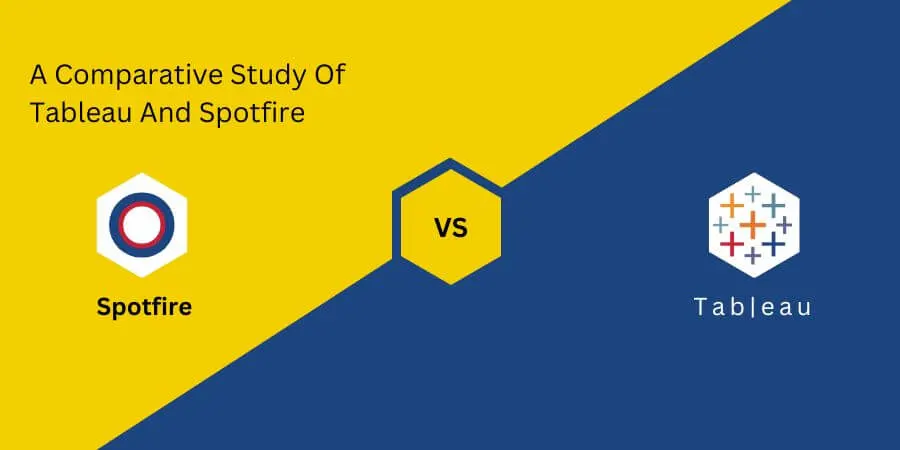
Data visualization plays a pivotal role in comprehending and interpreting complex data sets. With the advent of advanced analytics tools, firms have access to potent platforms that help them transform raw data into actionable insights. Two renowned players in the field of data visualization are Tableau vs Spotfire.
Tableau - An Overview:
Tableau is nothing but a leading data visualization and analytics platform renowned for its intuitive interface and interactive visualizations. It permits users to explore and communicate data insights effectively through visually appealing charts, graphs, and dashboards. Tableau consulting services company provides user-friendly design and drag-and-drop functionality makes it effortless and accessible to users at all levels.
Key Features Of Tableau:
- Intuitive Data Visualization: Tableau offers a wide range of interactive visualizations. Users can easily construct visually engaging dashboards by dragging and dropping fields onto the canvas, permitting quick exploration and analysis of the data.
- Seamless Data Connectivity: Tableau provides seamless connectivity to distinct data sources, including databases, spreadsheets, cloud services, and big data platforms. It offers native connectors for renowned databases, permitting users to connect, extract, and analyze data from multiple sources.
- Self-Service Analytics: Tableau empowers business users and data analysts with self-service analytics capabilities. It permits them to construct ad hoc queries, perform calculations, apply filters, and explore data freely without relying on IT departments. This flexibility promotes a culture of data exploration and empowers users to uncover insights independently.
- Collaboration And Sharing: Tableau facilitates real-time collaboration among team members, permitting them to share dashboards, insights, and reports. Users can publish and share interactive dashboards online or embed them in web pages, allowing stakeholders to access and interact with data from anywhere. Additionally, Tableau's subscription and alerting features ensure that users stay informed about data changes and updates.
- Mobile Accessibility: Tableau provides a mobile app for iOS and Android devices, permitting users to access and interact with dashboards on the go. This feature ensures that decision-makers have access to critical insights even when they are not in the office.
Understanding Spotfire:
Spotfire is a comprehensive analytics platform that combines data visualization with advanced analytics capabilities. It offers a distinct range of features to help users explore, analyze, and understand their data effectively.
Key Features Of Spotfire:
- Advanced Analytics: Spotfire possesses advanced analytics capabilities, specifically data mining, statistical modeling, and predictive analytics. It offers a wide range of statistical functions, algorithms, and visualizations to help users uncover patterns, correlations, and trends in their data.
- Interactive Dashboards: Spotfire permits users to construct interactive dashboards with dynamic filtering and drill-down capabilities. Users can easily navigate through the data and drill into specific aspects for deeper analysis. Spotfire also provides multiple visualization options, such as heat maps, scatter plots, and treemaps, to present data in a visually appealing manner.
- Data Wrangling And Transformation: Spotfire offers robust data wrangling capabilities, permitting users to clean, transform, and blend data from multiple sources. It provides an intuitive interface for data preparation tasks such as data cleansing, merging, and reshaping, enabling users to work with disparate data sets efficiently.
- Real-Time Data Streaming: Spotfire supports real-time data streaming, permitting users to analyze and visualize live data as it flows into the system. This feature is particularly useful for industries that require real-time monitoring and decision-making.
- Collaboration And Automation: Spotfire provides collaboration features that enable users to share insights, dashboards, and analyses with colleagues. It also supports automation through the use of scripts and workflows, permitting users to automate repetitive tasks and streamline data analysis processes.
Pros And Cons - A Comparison:
Tableau vs Spotfire excel in different areas, offering unique features and functionalities to users. Tableau stands out for its user-friendly interface, ease of use, and self-service analytics capabilities. It empowers firm users and data analysts to explore data independently and construct visually appealing dashboards with minimal technical expertise. However, Tableau's advanced analytics capabilities may be relatively limited compared to Spotfire.
Spotfire, on the other hand, shines in its advanced analytics capabilities, offering a wide range of statistical functions, predictive analytics, and data mining features. It caters to users who require complex analysis and modeling capabilities.
Spotfire's data wrangling and transformation capabilities provide a robust platform for data preparation tasks. However, Spotfire may have a steeper learning curve and require more technical expertise compared to Tableau.
Points Worth Noting:
Tableau is extensively employed for business intelligence and reporting purposes, enabling users to create interactive dashboards, drill down into data, and generate insightful reports. Tableau's intuitive interface and data exploration capabilities make it popular for data analysis and research. It is also implemented for sales and marketing analytics, helping firms track performance, analyze customer behavior, and optimize campaigns.
Spotfire is widely used across distinct industries and use cases. In the pharmaceutical and life sciences industries, it helps with drug discovery, clinical trial analysis, and genomics research. In manufacturing, it optimizes processes, supply chain management, and quality control. For the energy and utilities sectors, it analyzes energy consumption, optimizes resource allocation, and enables predictive maintenance.
Conclusion:
In the world of data visualization and analytics, Tableau vs Spotfire are both potent platforms with distinct strengths and use cases. Tableau's intuitive interface, self-service analytics, and strong focus on data visualization make it an ideal option for firms seeking user-friendly and visually appealing dashboards.
On the other hand, Spotfire's advanced analytics capabilities, real-time data streaming, and robust data wrangling functionalities cater to users who require sophisticated analytics and data preparation features.
The choice between Tableau vs Spotfire depends on specific business needs, the complexity of data analysis requirements, technical expertise, and budget. It is recommended to evaluate these platforms based on factors such as data visualization preferences, advanced analytics needs, collaboration requirements, scalability, and the skill set of users. Ultimately, both Tableau vs Spotfire empower organizations to unlock the value of their data and make data-driven decisions, providing a competitive edge in today's data-driven landscape.